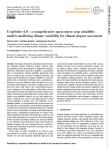Zabel F., Knüttel M., Poschlod B. (2025). CropSuite v1.0-a comprehensive open-source crop suitability model considering climate variability for climate impact assessment. Geoscientific Model Development, 01/02/2025, vol. 18, n. 4, p. 1067-1087.
https://doi.org/10.5194/gmd-18-1067-2025
https://doi.org/10.5194/gmd-18-1067-2025
| Titre : | CropSuite v1.0-a comprehensive open-source crop suitability model considering climate variability for climate impact assessment (2025) |
| Auteurs : | F. Zabel ; M. Knüttel ; B. Poschlod |
| Type de document : | Article |
| Dans : | Geoscientific Model Development (vol. 18, n. 4, February 2025) |
| Article en page(s) : | p. 1067-1087 |
| Langues : | Anglais |
| Langues du résumé : | Anglais |
| Catégories : |
Catégories principales 07 - ENVIRONNEMENT ; 7.6 - Changement ClimatiqueThésaurus IAMM CHANGEMENT CLIMATIQUE ; TERRE AGRICOLE ; APTITUDE DES TERRES ; EVALUATION DES TERRES ; MODELE |
| Résumé : | Increasing demand for agricultural land resources and changing climate conditions require strategic land-use planning and the development of adaptation strategies. Therefore, information about the suitability of agricultural land is a prerequisite. Current suitability approaches often focus on single crops, can only be applied regionally, and usually neglect the impact of climate variability on crop suitability. Here, we introduce CropSuite, a new, comprehensive, and easy-to-use crop suitability model that allows us to overcome these shortcomings. It provides a graphical user interface (GUI) and a wide range of pre- and postprocessing options, including a tool for data analysis, which allows users to easily apply the model and analyze the results. Further, it includes a spatial downscaling approach to climate data, which enables crop suitability analysis at very high spatial resolution. CropSuite uses a fuzzy-logic approach and is based on the assumption of Liebig's law of the minimum. An expandable number of environmental and socioeconomic factors that affect crop suitability can be flexibly integrated into CropSuite by determining membership functions. CropSuite allows for the consideration of irrigated and rainfed agricultural systems, vernalization requirements for winter crops, lethal temperature thresholds, photoperiodic sensitivity, and several other limitations for crop growth. The model endogenously calculates and outputs climate, soil, and crop suitability, the optimal sowing and harvest dates, the potential for multiple cropping, the (most-)limiting factor(s), and the recurrence rate of potential crop failure according to the inter-annual climate variability.In this study, we apply CropSuite to 48 crops at a spatial resolution of 30 arcsec (1 km at the Equator) for Africa. Thereby, we consider regionally important staple and cash crops that are usually understudied, such as coffee, cassava, banana, oil palm, cocoa, cowpea, groundnuts, mango, millet, papaya, rubber, sesame, sorghum, sugar cane, tobacco, and yam. We find that the consideration of climate variability when calculating crop suitability makes a significant difference to suitable areas but also affects optimal sowing dates and multiple cropping potentials. The most vulnerable regions for climate variability are identified in Somalia, Kenya, Ethiopia, South Africa, and the Maghreb countries. The results provide valuable crop-specific information that can be further used for climate impact assessments, adaptation, and land-use planning at the global, regional, or local scale. CropSuite is provided as open-source code and could be of interest for model developers, scientists, and a wide range of potential users and stakeholders, such as farmers, companies, governmental organizations (GOs), and non-governmental organizations (NGOs). |
| Cote : | En ligne |
| URL / DOI : | https://doi.org/10.5194/gmd-18-1067-2025 |







